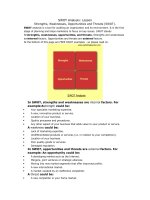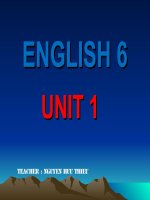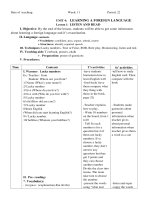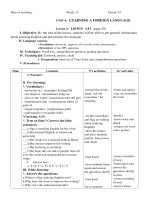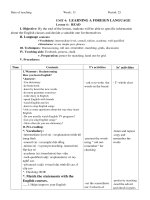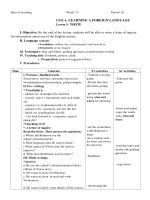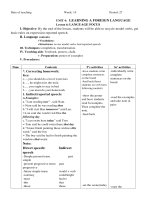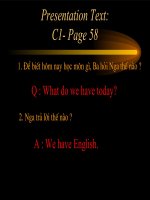English8 lesson planningtrial
Bạn đang xem bản rút gọn của tài liệu. Xem và tải ngay bản đầy đủ của tài liệu tại đây (165.85 KB, 12 trang )
<span class='text_page_counter'>(1)</span><div class='page_container' data-page=1>
<i>Date of preparation:12/8</i>
<i>Date of teaching:16/8</i>
Period 1:
Revision & test
<b>I/ Objectives:</b>
<b>+ The aim: By the end of the lesson students will be able to:</b>
- Remember all basic knowledge in the seventh form:
- The past simple tense
- Simple future tense, present progressive
- Comparatives and superlatives
<b>+ Contents:</b>
<i>Vocabulary: </i>
<i>Grammar: </i>
<i>Skill: L-S-R-W.</i>
<b>II/ Teaching aids: Picture, tape cassette.</b>
Books and notebooks
<b>III/ Procedure:</b>
<b>T s and SS activities</b>’ ’ <b>Contents</b>
Warm up: <b> ( 7 )</b>
T checks S ‘s books and school
things.
-T asks some questions.
-SS answer.
- Review 3 tenses
- Adv of tense?
- Verbs?
- Example
While
<b>(14 )</b>’
- Negative?
- Change 2 sentences into negative
- Interrogative?
- Change 2 sentences into
interrogative
- Adverbs?
- Verbs?
- Example
- Negative
- Change 2 sentences
- Interrogative?
- Change 2 sentences
- Adverbs?
- Verbs?
<i>Questions: </i>
1. How are you today?
2. What is the date?
3. How many people are there in
your class? Who is absent today?
4. Who is the monitor?
..
……
<b>1, The present progressive tense</b>
adv: now, at the moment
Verbs: am/ is/ are + V-ing
a, Mai and Hoa (skip) rope now.
b, I (teach) English at the moment.
- Add “not” behind am/ is/ are
Ex: Mai and Hoa are not skipping
I am not teaching English at the
moment.
- Change is/ am/ are in front of S
<b>2, The simple future tense</b>
adv: next, tomorrow, tonight
<b>Verb: am/ is/ are going to + V</b>
will + V
+ Nga (watch) TV tonight.
+ They (go) to school tomorrow.
- Add “not” behind Be or Will
- change Be or Will in front of S
<b>3, The past simple tense</b>
adv: last, yesterday, ago
Verbs: Be – was/ were
Can – Could
Ordin – Verb/ V2
</div>
<span class='text_page_counter'>(2)</span><div class='page_container' data-page=2>
- Example
- Negative?
- change 3 sentences
- Interrogative?
- change 3 sentences
Post
<b>(7 )</b>‘
- How many modal verbs have you
learnt?
- What are they?
- How to use?
- Negative?
- Interrogative?
-Retell how to use comparatives and
superlatives
Test : 10'
- Nam (play) soccer two day ago.
(-) Be/ can: Add “not” behind
was/were
Ordin : Add “didn’t” in front of V
(?) Be/can: change were/was/could in
front of S
Ordin: Add “did” in front of S + V
<b>4, Modal verbs</b>
*form : Modal + V
(- ) Add "not" behind modal
(?) Change Modal in front of S
5, Comparatives.
Adj Comparatives Superlatives
Good better the best
Small smaller the smallest
Beautiful more beautiful most
beautiful
* The use of adj/adv.
<b>* Put the verb in correct form</b>
1, My mother (go) to work yesterday
2, Students (play) games now
3, Nga (do) her home work tonight
4, She (wash) her clothes last night
* Translate in to English
1, Hoa thông minh nhất lớp cơ ấy
2, Tơi đã học TA 7 năm ngối.
<i><b>* Homework: (2 )</b></i>
- Guides SS How to learn English 8.
- Prepare new lesson: Unit 1: Getting started + Listen and read.
<i>Date of preparation:17/8</i>
<i>Date of teaching:19/8</i>
Period 2:<sub> Unit 1:</sub>
My friends
Getting started + Listen and read
<b>I/ Objectives:</b>
<b>+ The aim: By the end of the lesson students will be able to:</b>
- Describe their favorite activities.
- Describe their friends.
<b>+ Contents:</b>
<i>Vocabulary: seem</i> next – door neighbor smile enough
<i>Grammar: What do/ does </i>… look like?
Enough to do something
</div>
<span class='text_page_counter'>(3)</span><div class='page_container' data-page=3>
<b>II/ Teaching aids: Picture, tape cassette.</b>
Books and notebooks
<b>III/ Procedure:</b>
<b>T s and SS activities</b>’ ’ <b>Contents</b>
<b>1-Warm up: Presentation: (18 )</b>’
-T presents the topic of the lesson.
-SS say about their favorite activities.
-T writes them on the board.
-T shows the picture and presents.
-T asks some questions about people
in the picture:
<i>What are these children doing? </i>
<i>Where are they? </i>
<i>Are they all boys? (girls)?</i>
<i>What time of the day do you think it </i>
<i>is? </i>
<i>Do girls play soccer? Do you like </i>
<i>soccer? Do you play soccer and </i>
<i>where do you play soccer?</i>
-SS work in pairs: Ask and answer
about the pictures.
-Some SS practice aloud before class.
<i>-T asks SS about their similar </i>
<i>activities: Do you play soccer after </i>
<i>school? </i>
<i>Do you play cards at recess? </i>
<i>Who (m) do you like to play with? </i>
<i>A person who is better than you or </i>
<i>weaker than you? In a team group or</i>
<i>individually? </i>
-SS answer.
<b>2-Practice: (14 )</b>’
-T presents the situation of the
dialogue.
-T asks some questions about Hoa:
<i>Who s Hoa? Where is she from? </i>’
<i>Whom does she live with now? </i>
-T introduces the content of the
<i>dialogue: Hoa is talking to Lan. She </i>
<i>describes about her friend Nien. </i>
-T plays the tape.
-SS listen and repeat.
-T presents new words and new
structures.
-Some pairs of SS practice aloud.
-T corrects the mistakes.
-T guides SS to ask and answer the
questions.
-SS work in pairs.
-Some pairs of SS practice aloud.
-T gives answer key.
I/. getting started:
<i>Children favorite activities: </i>
- Play soccer.
- Play volleyball.
- Play badminton
- Play chess/ cards
- Read books
- Going out, picnic, camping…
<b>a-These boys like playing soccer. </b>
<b>b-These girls like reading. </b>
<b>(studying together) </b>
<b>c-These two boys like playing </b>
<b>chess. </b>
<b>d-These boys and girls like playing </b>
<b>volleyball. </b>
II/. Listen and read:
<i>*New words: </i>
<b>seem (a): dêng nh</b>
<b>next doorneighbor: ngời cạnh nhà, </b>
hàng xóm.
<b>smile ( n)</b> : nụ cời, mØm cêi
<b>enough</b> : đủ
<i>*Grammar: </i>
<b>1-What + be + S + like? </b>
(đợc dùng để hỏi về chất lợng hay
tính tình)
<b>2-What + do/ does + S + look + like?</b>
(Đợc dùng để hỏi về hình dáng bên
ngồi)
<b>3-Adj/ adverbs + enough+ to + V </b>
<b>(infinitive) </b>
Ex: She isn’t old enough to be in my
class.
He studied hard enough to pass the
exam.
<b>4-What + (a/ an) + adj + N!</b>
(Câu cảm thán)
</div>
<span class='text_page_counter'>(4)</span><div class='page_container' data-page=4>
<b>3-Production: (6 )</b>
-T asks SS to write the answers in
their notebooks.
-Describe about one of their friends.
<i>*Answer the following questions: </i>
<i>a- She lives in Hue.</i>
<i>b-No. She doesn’t know Nien. </i>
<i>c- “She wasn’t old enough to be </i>
<i>in my class”.</i>
<i>d- She is going to visit Hoa at </i>
<i>Christmas.</i>
<b>4- Consolidation: Repeat the grammar of the lesson. (4 )</b>’
5-Homework: (3‘)
- Learn by heart new words and grammar.
- Practice dialogue and answer the questions.
- Prepare new lesson: Speak+LF1,2.
<i>Date of preparation:18/8</i>
<i>Date of teaching:20/8</i>
Period 3: Unit 1:
Speak+ Language focus 1+2
<b>I/ Objectives:</b>
<b>+ The aim: By the end of the lesson students will be able to:</b>
- Describe about people’s build and hair.
- Practice speaking.
- Review simple tenses.
<b>+ Contents:</b>
<i>Vocabulary: slim</i> straight curly bold dark
blond fair
<i>Grammar: S + be + Adjective</i>
S + have + Adjective + N
<i>Skill: Speaking+R+W.</i>
<b>II/ Teaching aids: Extra board</b>
Books and notebooks
<b>III/ Procedure:</b>
<b>T s and SS activities</b>’ ’ <b>Contents</b>
A/ Speak
<b>+ Checking old lesson: (3 )</b>’
-Two SS practice the dialogue.
-Answer the questions.
<i><b>1-Warm up:</b></i><b> (3 )</b>’
<i><b>-T guides SS to play Word storm.</b></i>
-SS play.
<i><b>2- New lesson: </b></i>
<b>a-Pre-Speaking: (8 )</b>’
<i>-T guides: In daily life, we always </i>
<i>have to communicate with other </i>
<i>people. Thus, it is important to know </i>
<i>the adjectives and structures </i>
<i>describing a person s appearance</i>’ <i>. In</i>
<i><b>Word storming</b></i>
<b>Color</b>
white black
Speak:
<i><b>1-Read the dialogue: </b></i>
<i>*Grammar: </i>
</div>
<span class='text_page_counter'>(5)</span><div class='page_container' data-page=5>
<i>this period, we will deal with this </i>
<i>matter. </i>
-T shows the picture and presents
about 6 people.
-SS listen and describe them in
Vietnamese.
-SS look at the picture and read new
adjective.
-T explains them.
-SS read new words chorally and
individually.
<b>b-While- Speaking: (10 )</b>’
-T reads the dialogue.
-SS listen and repeat.
-T reviews the structure.
-SS make sentences with them.
<i>-T guides SS to practice: Now look at</i>
<i>the pictures a, b, c, d, e, f. You make </i>
<i>up similar dialogues by using the </i>
<i>adjectives and dialogue you have </i>
<i>practiced to describe the people in </i>
<i>the pictures: Van, Mr. Lai, Miss </i>
<i>Lien, Ann, Mr. Khoi and Mary. </i>
-SS work in pairs.
-Some pairs of SS practice aloud.
-T corrects the mistakes and gives
suggested answer.
<b>c-Post-Speaking: (6 )</b>’
<i><b>-T guides SS to play guessing game.</b></i>
T shows the picture of a famous
person.
Divide class into two groups.
Group A describe the person in the
picture.
Group B guess who he/ she is.
-One student describes a classmate
and the other has to guess.
<b>B/ LF 1+2 (13 )</b>’
1-Warm up:
-T asks SS to repeat about present
simple and past simple:
+ usage
+ structure
-T presents the lesson.
2-Activity 1:
-T explains the request of exercise.
-SS look at the exercise and listen.
-T guides SS to do it.
-SS work in pairs.
-Some pairs of SS practice aloud.
Ex: I have long and black hair.
He has short and brown hair.
<b>S + be + adjectives</b>
Ex: She is short and thin.
You are slim.
<i><b>2-Now take turns to make similar </b></i>
<i><b>dialogues: </b></i>
<i>*New words: </i>
<b>slim</b> [slim]: mảnh khảnh, mảnh de
<b>straight </b>[streit]: thẳng, không cong
<b>curly </b>['kə:li]: quăn
<b>bold </b>[bould]<b>: hãi</b>
<b>dark </b>[dɑ:k] thẫm sẫm (màu)
<b>blond</b> [blond]: vàng hoe
<b>fair</b>[feə]: vµng nh¹t
A: What does Van look like?
B: He is tall and thin. He has short
black hair.
..
………
Language focus:
<i>1-Complete the paragraphs. Use the </i>
<i>correct form of the verbs in brackets:</i>
a) lived lives
sent was
is
b) is are
came showed
introduced
<i>2-Complete the dialogue: </i>
New words:
<b>rise</b> [raiz] mọc (mặt trời, mặt trăng...)
<b>set</b> [set] lặn
<b>earth</b> [ə:θ](n): đất, mặt đất, quả đất
</div>
<span class='text_page_counter'>(6)</span><div class='page_container' data-page=6>
-T emphasizes some adverbs of time.
-SS compare the past simple with
present simple.
-T corrects the exercise.
3-Activity 2:
-T explains grammar: Present simple
to talk about general truths.
-SS copy and make sentences with it.
-T explains the request of exercise
and guides SS to do it.
-T explains the verbs given.
-SS work in pairs.
-SS compare the answers with a
partner.
-Some SS read out the answers.
-T corrects the mistakes.
-Some pairs of SS practice the
dialogue before class.
<b>planet</b> ['plænit](n)(thiên văn học) hành tinh
<b>Mars</b> [ma:z](n): sao Hoả, Thần chiến tranh
<b>Mercury</b> ['mə:kjuri](n): Sao Thuû
<b>grocery</b> ['grousəri] cửa hàng tạp hoa
<b>It’s silly: ThËt ngèc </b>
<b>1 – sets</b> <b>2 – goes</b> <b>3 – moves</b>
<b>4 – is</b> <b>5 – is</b> <b>6 – is</b>
<i><b>3- Consolidation: </b></i><b>(4 )</b>’
Repeat the content of the lesson.
<i><b>4-Homework:</b></i><b> (1 )</b>’
- Learn by heart new words and structures.
- Describe some people.
- Prepare new lesson: Listen.
<i>Date of preparation:20/8</i>
<i>Date of teaching:23/8</i>
Period 4: Unit 1:
Listen+ LF 3+4
<b>I/ Objectives:</b>
<b>+ The aim: By the end of the lesson students will be able to describe someone and </b>
complete the dialogue by listening.
Practice listening.
<b>+ Contents:</b>
<i>Vocabulary: set</i> earth moon planet rise
</div>
<span class='text_page_counter'>(7)</span><div class='page_container' data-page=7>
<i>Grammar: Present simple to talk about the general truths. </i>
(Not) Adjective + enough + to - infinitive
<i>Skill: Listening & speaking. </i>
<b>II/ Teaching aids: Tape cassette.</b>
Books and notebooks
<b>III/ Procedure:</b>
<b>T s and SS activities</b>’ ’ <b>Contents</b>
I/ Listen
+ Checking old lesson: <b> (4 )</b>’
SS describe a person’s build.
<i><b>1-Warm up:</b></i><b> (5 )</b>’
<i><b>-T guides and asks SS to play Ask </b></i>
<i><b>and answer.</b></i>
-T gives a form has some questions.
-SS work in pairs, ask and answer the
questions.
-T corrects the mistakes.
<b>features</b> ['fi:t∫ə]: nét đặc biệt, điểm đặc trưng
<b>beards</b> [biəd]râu
<i><b>2- New lesson:</b></i>
a-Pre-Listening: <b> (5 )</b>’
-T asks some questions to guide:
<i>What do you say if you want to meet </i>
<i>someone? </i>
<i>What will you say when you are </i>
<i>introduced to someone? </i>
-SS listen and answer.
-T explains and reviews.
-SS copy.
-T asks SS to read the dialogues.
-SS read them to catch information.
-SS guess the exercise.
b-While-Listening: <b> (7 )</b>’
<i>-T presents: We are going to listen to </i>
<i>4 dialogues illustrating different </i>
<i>situations. Each dialogue has some </i>
<i>missing information. You listen to the</i>
<i>tape and complete the dialogues.</i>
-T plays the tape three times.
-SS listen carefully and complete.
-SS compare the answers with a
partner.
-Some pairs of SS read out the
answers.
-T plays the tape again.
-SS listen and check the answers.
-4 pairs of SS practice the dialogues
aloud.
<i>*Questions: </i>
How tall are you?
How would you describe your
build?
What color are your eyes?
What kind of hair do you have?
What color is it?
Do you like it look different? If so,
in what way?
Do you think you have any
special features?
Do you like the beards?
Can you think of a famous
woman you describe as beautiful,
and a man you describe as
handsome?
Listen:
<i>Listen and complete the </i>
<i>conversations. Use the expressions </i>
<i>in the box: </i>
<b>a- I’d like you to meet (1)</b>
<b> Nice to meet you (2)</b>
<b>b- I’d like you to meet (3)</b>
<b> It’s a pleasure to meet you (4)</b>
<b>c- come and meet (5)</b>
<b> </b>
</div>
<span class='text_page_counter'>(8)</span><div class='page_container' data-page=8>
c-Post-Listening: <b> (3 )</b>’
-T guides SS to make the similar
dialogues.
-SS work in pairs.
II/ LF 3+4
1-Activity 3: <b> (15 )</b>’
-T requests SS to look at the picture
and explains the request of exercise.
-SS look at the picture carefully.
-SS practice in pairs, ask and answer
the questions.
-Some pairs of SS practice aloud
before class.
-T corrects the mistakes.
Notice: SS ask and answer questions
with out books.
2-Activity 4:
-T presents the usage of the structure.
-SS notice and make sentences with
it.
-T guides SS to do exercise.
-SS work in pairs.
-Some pairs of SS practice aloud.
-T corrects and gives answer key.
<i>3-Look and describe: </i>
a- There are four people in the picture.
b- There is a tall, heavy – set man; There
is a tall thin woman with short hair; There
is a boy sitting on the ground, holding his
head; And there is a short man standing
across the street.
c- The man standing next to the taxi is
wearing a yellow shirt and black trousers;
The woman is carrying a shoulder bag,
and is wearing a green skirt and red
blouse. The boy sitting on the ground
and holding his head is wearing blue
shorts and white shit; The man crossing
the street is wearing blue trousers and
pink shirt.
<i>4-Complete the dialogues:</i>
<b>(Not) Adjective + enough + to - infinitive </b>
<b>a-It is not big enough to carry </b>
everything.
<b>b-Ba is not old enough to drive a car.</b>
<b>c-I am strong enough to lift this box.</b>
<b>d- I don’t think my English is good </b>
<b>enough to be a member.</b>
<i><b>3- Consolidation: (3 )</b></i>”
Repeat the content of the listening.
<i><b>4-Homework:(1 )</b></i>’
- Make the similar dialogues.
- Learn by heart the dialogues.
- Prepare new lesson: Read.
===================================================
<i>Date of preparation:22/8</i>
<i>Date of teaching:25/8</i>
Period 5: Unit 1:
Read
<b>I/ Objectives:</b>
<b>+ The aim: By the end of the lesson students will be able to know more about Ba’s </b>
friends.
</div>
<span class='text_page_counter'>(9)</span><div class='page_container' data-page=9>
<b>+ Contents:</b>
<i>Vocabulary: character</i> orphanage joke sociable
generous reserved outgoing annoy hard- working
sense of humor
<i>Grammar: Spresent tense</i>
<i>Skill: Reading-W-S</i>
<b>II/ Teaching aids: Extra board</b>
Books and notebooks
<b>III/ Procedure:</b>
<b>T s and SS activities</b>’ ’ <b>Contents</b>
+ Checking old lesson: <b> (5 )</b>’
-Two pairs of SS practice the
dialogues.
<i><b>1-Warm up:</b></i>
<i><b>-T guides SS to play Find someone </b></i>
<i><b>who.</b></i>
-SS play.
<i><b>2- New lesson:</b></i>
a-Pre-Reading: <b> (10 )</b>’
<i>-T guides and presents: This game </i>
<i>tells you the characters of people in </i>
<i>the class. Which adjectives do you </i>
<i>use to describe the one who always </i>
<i>helps other people? </i>
(kind/ helpful)
<i>Or the one who always tells jokes? </i>
(humorous)
-SS listen and answer.
-T gives SS some new words.
-SS copy, read the new words
chorally and individually.
b-While-Reading: <b> (11 )</b>’
<i>-T guides: You are going to read the </i>
<i>text about Ba s friends. Each one has</i>’
<i>his own characters. You scan the </i>
<i>reading and tell me how many </i>
<i>people the text describes.</i>
-SS listen, read the text and answer.
-T gives some questions.
-SS read the text again and answer.
-Some pairs of SS ask and answer
aloud.
-T gives answer key.
-T guides and asks SS to do exercise
1.
-SS choose the best answer.
-SS compare the answers with a
partner.
<i><b>Find someone who…</b></i> Name
Usually helps other people
Doesn’t speak a lot in public
Always goes to the library
Sometimes tells funny stories
Smiles a lot
………..
Read:
Ba is talking about his friends:
<i>*New words: </i>
<b>Character </b>['kæriktə] (n): tính nết; tính cach;
ca tính
<b>orphanage</b> ['o:fənidʒ] (n): trại mồ côi
<b>joke</b> [dʒouk](n): lời nói đùa, câu nói đùa
<b>sociable</b> ['sou∫əbl](a): dễ gần gũi, dễ chan
hoà, hoà đồng
<b>generous</b> ['d3enərəs](a): rộng lượng, khoan
hồng, rộng rãi, hào phóng
<b>reserved</b> [ri'zə:vd](a): kín đao; dè dặt
<b>outgoing</b> ['autgouiη](a): thân mật và thoải
mai
<b>annoy</b> [ə'noi](v): quấy rầy, làm phiền, làm
trai ý, làm khó chịu
<b>hard- working</b> ['hɑ:d'wə:kiη](a): làm việc tích
cực và chu đao
<b> sense of humor = humorous:</b> khôi hài, hài
hước; hóm hỉnh
<i>Questions: </i>
1-How many friends does Ba have?
2-What is Bao like?
3-What does Bao like doing in his free
time?
4-What are Song and Khai like?
5-What does Song look like?
6-What does Bao like doing?
</div>
<span class='text_page_counter'>(10)</span><div class='page_container' data-page=10>
-Some SS read out the answers.
-T corrects.
-T guides SS to do exercise 2.
-SS read out the questions.
-T explains some difficult questions.
-SS read the text again and answer in
pairs.
-Some pairs of SS practice aloud.
-Some SS read out the passage.
c-Post-Reading: <b> (7 )</b>’
-T asks SS to think over their friends
and describe about them.
1/. Choose the best answer:
a- A c- B
b- C d- D
2/. Now answer the questions:
a. He feels happy and lucky.
b. Bao is the most sociable.
c. Khai likes reading books in the
local library.
d. Ba’s jokes sometimes make his
friends annoyed.
e. Bao usually spends his free time
at the local orphanage.
f. I and my friends, of course, have
different characters.
<i><b>3- Consolidation:</b></i><b> (4 )</b><i><b>’ Repeat the content of the text.</b></i>
<i><b>4- Homework:</b></i><b> (1 )</b>’ - Translate the text and retell the content.
- Answer the questions.
- Prepare new lesson: Write.
=====================================================
<i> Date of preparation: 23/8</i>
<i>Date of teaching: 26/8</i>
Period 6: Unit 1:
Write
<b>I/ Objectives:</b>
<b>+ The aim: By the end of the lesson students will be able to write some sentences </b>
about themselves or their close friends.
<b>+ Contents:</b>
<i>Vocabulary: appearanced words</i>
<i>Grammar: simple present</i>
<i>Skill: Writing. </i>
<b>II/ Teaching aids: Extra board</b>
Books and notebooks
<b>III/ Procedure:</b>
<b>T s and SS activities</b>’ ’ <b>Contents</b>
+ Checking old lesson: <b> (4 )</b>’
<i><b>1-Warm up:</b></i>
-T guides and asks SS to play
<i><b>Guessing games. </b></i>
<i>I never come to class late. What </i>
<i>character do I have? (punctual) </i>
<i>I like telling jokes. I always tell jokes</i>
<i>to my friends. What character do I </i>
<i>have? (humorous)</i>
..
………
<i>*Answer the questions: </i>
1-How does Ba feel having a lot of
friends?
2-Who likes reading?
3-What is a bad thing about Ba’s
jokes?
Write:
</div>
<span class='text_page_counter'>(11)</span><div class='page_container' data-page=11>
<i><b>2- New lesson:</b></i>
a-Pre-Writing: <b> (12 )</b>’
-T asks SS to look at the box and
<i>explains: This is Tam s personal </i>’
<i>card. You read it and tell me “What </i>
information is there on the card?”
-SS read and answer.
-T explains the personal card.
-SS notice.
<i>-T guides: Base on this information, </i>
<i>we have a paragraph describing </i>
<i>Tam. Can you tell me how Tam is </i>
<i>described? </i>
-SS read the passage aloud.
-T asks SS to look at part 2 and
continues guiding.
-SS work in pairs, ask and answer the
questions.
b-While-Writing: <b> (10 )</b>’
-T shows an information paper and
explains.
-T guides SS to ask and fill
information about their friends.
-SS work in pairs.
-A student fills on the extra board.
<i>-T guides: Now using the writing </i>
<i>sample in part 1 and the answers in </i>
<i>part 2, you write a paragraph about </i>
<i>your friends.</i>
-SS write individually.
-SS do peer correction.
-Some SS read out their writing.
-SS and T correct the mistakes.
c-Post-Writing: <b> (10 )</b>’
-T shows the extra board which have
some information about Van.
-SS write in groups of six.
-SS show their writing on the board.
-T corrects the mistakes.
1-What s his name? <b>’</b>
2-How old is he?
3-What does he look like?
4-Where does he live?
5-Who does he live with?
6-What is he like?
7-Who are his best friends?
<i>2/. Fill in a similar form for your </i>
<i>partner. </i>
Name:
<i><b>Appearance: tall, thin, slim, short, </b></i>
<i><b>fat </b><b>…</b><b>long or short hair</b><b>…</b></i>
<i><b>Characters: funny, helpful, sociable, </b></i>
<i><b>generous, reserved, outgoing…</b></i>
Address:
<i><b>Family: Father, mother, sister, </b></i>
<i><b>brother…</b></i>
Friends:
<i>3/. Now write a paragraph about </i>
<i>your partner: </i>
Sociable and kind
Ly, Thuy
Mai, Ha
<b>Van</b>
Uncle and aunt 145 Nguyen Cong
Hoan Street
<i><b>3- Consolidation: (3 )</b></i>’
Repeat the content of the lesson.
<i><b>4-Homework:(2 )</b></i>’
- Note the form of a letter.
</div>
<span class='text_page_counter'>(12)</span><div class='page_container' data-page=12></div>
<!--links-->
